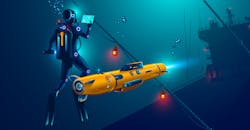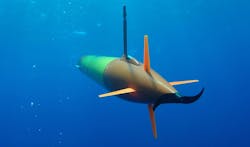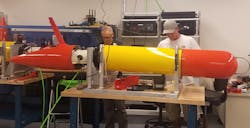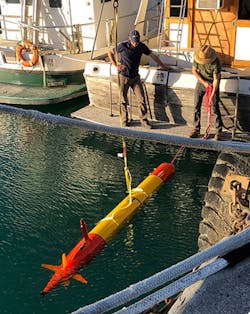Autonomous Robots Set Sail to Explore the Ocean
The ocean is essential to sustaining human life on earth. It works as a filter for our environment, cleaning and replenishing our atmosphere, while providing nutrients for our sea life. However, our knowledge of the ocean is limited. The first deep sea exploration only occurred in 1960, less than 60 years ago. That’s why scientists are using modern robotic and sensing technology to develop new tools to help study the ocean to predicts its future behavior and health.
The Benefits of Studying Ocean Microbes
A long-range autonomous underwater vehicle (LRAUV) cruises beneath the surface during field trials in Hawaii. (Image courtesy of Elisha Wood-Charlson, University of Hawaii)
Ocean microbes are tiny, single-celled organisms that account for more than 98% of the ocean biomass. The term “ocean microbe” covers several different microorganisms, including microalgae, bacteria and archaea, protozoa fungi, and viruses. They are exceedingly small, measuring only 1/8000th the volume of a human cell and spanning about 1/100th the diameter of a human hair. It is possible for up to a million ocean microbes to live in just one milliliter of seawater.
Ocean microbes are processing factories that exist in highly organized, interactive, versatile communities. They receive their power from various methods, including solar radiation and chemosynthesis. Ocean microbes produce at least 50% of the oxygen in the atmosphere. They also help filter out and remove large amounts of carbon dioxide. Microbes found in the ocean help form the marine food webs that help supply food to global ocean fisheries.
According to the National Oceanic and Atmospheric Administration, the majority of ocean microbes remain under-sampled and uncharted. Their systems are complex and difficult to analyze. They can evolve rapidly in response to environmental shifts, and along with driving change in the environment, they can be used as indicators of environmental change.
Advances in Ocean Observation Technology
Brett Hobson from MBARI and Gabe Foreman from the University of Hawaii prepare a LRAUV for field trials. (Image courtesy of Chris Preston/MBARI)
For the first time, a small fleet of long-range autonomous underwater vehicles (LRAUVs) will be deployed to collect and archive seawater samples automatically. Scientists from the University of Hawaii at Mānoa (UH Mānoa) and the Monterey Bay Aquarium Research Institute (MBARI) are testing new ways of adaptively sampling oceanographic features such as open-ocean eddies—swirling masses of water that move slowly across the Pacific Ocean—which can have large effects on ocean microbes.
Edward DeLong and David Karl, oceanography professors in the UH Mānoa School of Ocean and Earth Science and Technology (SOEST) have been studying ocean microbes for decades. In February 2018, DeLong, Karl, and MBARI engineers completed construction and testing of three new LRAUVs that will be deployed in Hawaiian waters.
The LRAUVs, while in the ocean, will collect information on water temperature, chemistry, and chlorophyll. This data will be sent back to scientists on shore and in nearby ships. The underwater vehicles have an integrated Environmental Sample Processor (ESP). An ESP is a miniature robotic laboratory that collects and preserves seawater samples at sea, allowing researchers to capture a snapshot of the organisms’ genetic material and proteins.
MBARI engineers Brett Hobson and Brian Kieft dunk-test a LRAUV in Honolulu Harbor. (Image courtesy of Chris Preston/MBARI)
These ESPs have been a 15-year-long project for MBARI. The initial instrument was the size of 55-gallon drum. The latest third generation of ESPs are 1/10th of the original size, 8 to 10 in. in diameter. They were specifically designed to fit inside the LRAUV. This allows the research team to discover, track, and sample open-ocean eddies over 100 kilometers across for months at a time. The LRAUVs can transit over 600 miles and use their own monitoring equipment to detect and steer towards important oceanographic events like phytoplankton blooms.
The expeditionary cruise aboard the Schmidt Ocean Institute’s (SOI) research vessel Falkor left on March 10th for the first LRAUVs open-ocean sea trials. The research team will locate ocean eddies using satellite data and the deploy the LRAUVs to collect samples. DNA will be extracted from the filters, which will provide information on the eddy’s duration, stability, and influence on the ocean systems. This data will help improve ocean models to predict the expectations on the ocean’s future health.




